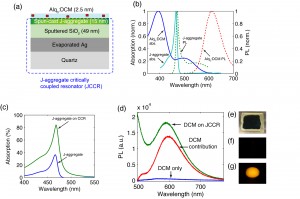20-fold Enhancement of Molecular Fluorescence by Coupling to a J-aggregate Critically Coupled Resonator
- Category: Optics & Photonics
- Tags: Gleb Akselrod, Vladimir Bulovic

Figure 1: (a) Enhancement structure schematic. (b) Absorption and emission spectra of materials in the system. (c) Absorption enhancement of J-aggregates due to the critically coupled resonator. (d) Spectrum of DCM emission for control sample and when coupled to JCCR. (e) Photograph of sample under ambient light. (f-g) Photographs of control DCM sample and DCM on JCCR.
The efficient absorption and emission of light is of fundamental importance to the operation of optoelectronic devices such as solid-state lighting, lasers, and photodetectors. The properties that determine the brightness of molecules and other luminescent species—absorption cross-section and emission quantum yield – are fundamental to the material and cannot be readily changed. It is thus highly desirable to have a device or general strategy for decoupling the absorption and emission properties of a luminescent thin film, so that the brightness of a lumiphore can be increased without changing its spectral emission properties or increasing the intensity of light for photoexcitation. Towards this end, work over the past decade has focused on the enhancement of fluorescence by coupling luminophores to metal nanoparticles, such as gold [1] .
Here we propose an alternative, purely exciton-based, approach to the enhancement of luminophore emission by coupling the luminophore to a highly absorbing resonant optical structure. The enhancement structure is based on a thin film of strongly absorbing J-aggregates placed at the anti-node of the electric field at a distance λ/4 away from a mirror, where λ is the wavelength of incident light. This placement results in destructive interference between the light reflected from the J-aggregate film and light that is reflected by the mirror and passed by the film. The structure (Figure 1a), here referred to as a J-aggregate critically coupled resonator (JCCR), can absorb up to 97% of the incident light [2] . The optical energy, localized in the form of excitons in the J-aggregate film, can then be coupled to luminophores deposited on the JCCR by Förster resonant energy transfer (FRET). As a result, the JCCR acts as a platform for dramatically enhancing the optical absorption cross-section of the target luminophore, leading to a subsequent enhancement in the emission. Such an architecture forms a highly general platform for fluorescence enhancement. A wide range of luminophores, both organic and inorganic, with emission spanning the visible and near IR, can be enhanced by simply choosing the appropriate J-aggregate material. In this work, we show a dramatic 20-fold enhancement in the emission of the laser dye DCM by utilizing the JCCR enhancement structure.
- J.-H. Song, T. Atay, S. Shi, H. Urabe, and A. V. Nurmikko, “Large enhancement of fluorescence efficiency from CdSe/ZnS quantum dots induced by resonant coupling to spatially controlled surface plasmons,” Nano Letters, vol. 5, pp. 1557-61, Aug. 2005. [↩]
- J. R. Tischler, M. S. Bradley, and V. Bulovic, “Critically coupled resonators in vertical geometry using a planar mirror and a 5 nm thick absorbing film,” Optics Letters, vol. 31, pp. 2045-2047, 2006 [↩]